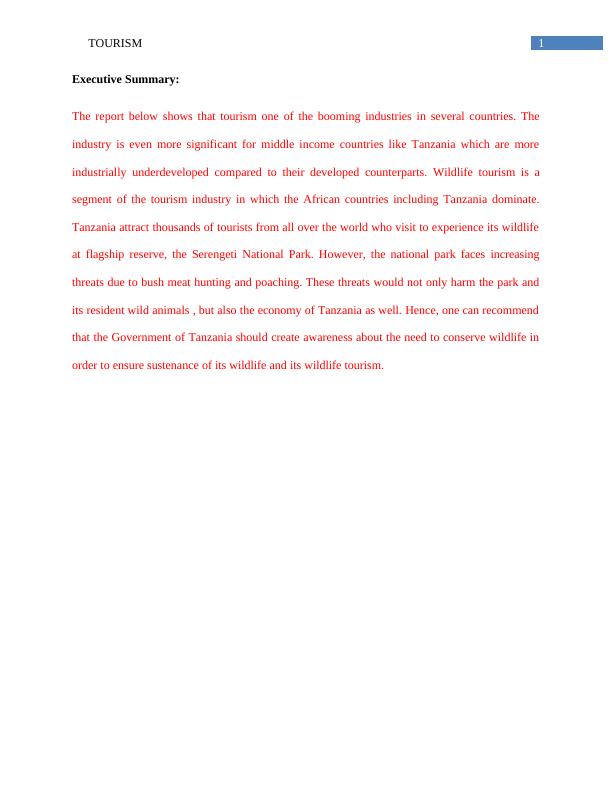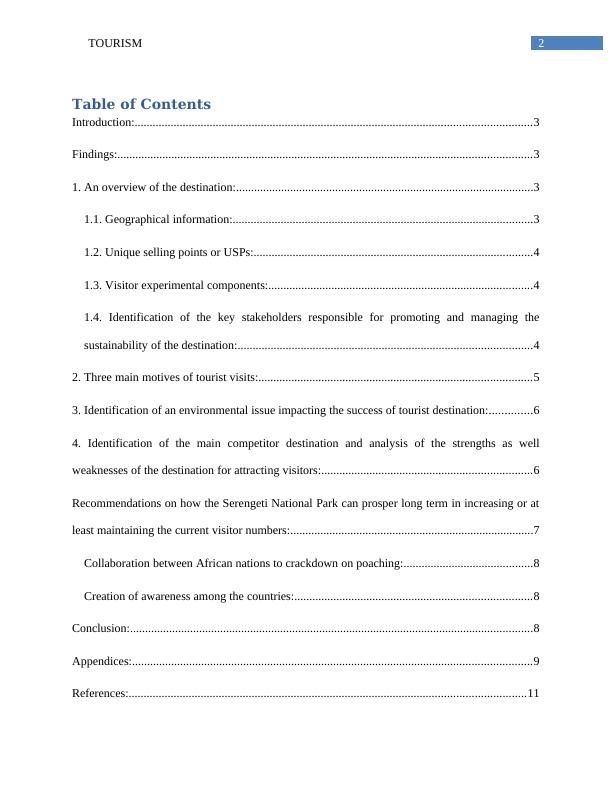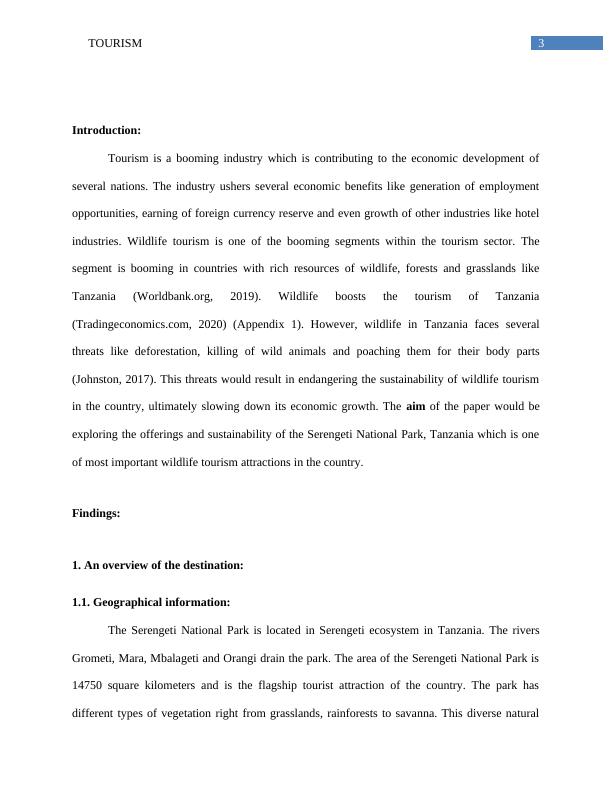Sustainability of the Serengeti-
Added on 2022-08-23
14 Pages2322 Words15 Views
Running head: TOURISM
Sustainability of the Serengeti National Park
Name of the student
Name of the university
Author Note:
Sustainability of the Serengeti National Park
Name of the student
Name of the university
Author Note:

1TOURISM
Executive Summary:
The report below shows that tourism one of the booming industries in several countries. The
industry is even more significant for middle income countries like Tanzania which are more
industrially underdeveloped compared to their developed counterparts. Wildlife tourism is a
segment of the tourism industry in which the African countries including Tanzania dominate.
Tanzania attract thousands of tourists from all over the world who visit to experience its wildlife
at flagship reserve, the Serengeti National Park. However, the national park faces increasing
threats due to bush meat hunting and poaching. These threats would not only harm the park and
its resident wild animals , but also the economy of Tanzania as well. Hence, one can recommend
that the Government of Tanzania should create awareness about the need to conserve wildlife in
order to ensure sustenance of its wildlife and its wildlife tourism.
Executive Summary:
The report below shows that tourism one of the booming industries in several countries. The
industry is even more significant for middle income countries like Tanzania which are more
industrially underdeveloped compared to their developed counterparts. Wildlife tourism is a
segment of the tourism industry in which the African countries including Tanzania dominate.
Tanzania attract thousands of tourists from all over the world who visit to experience its wildlife
at flagship reserve, the Serengeti National Park. However, the national park faces increasing
threats due to bush meat hunting and poaching. These threats would not only harm the park and
its resident wild animals , but also the economy of Tanzania as well. Hence, one can recommend
that the Government of Tanzania should create awareness about the need to conserve wildlife in
order to ensure sustenance of its wildlife and its wildlife tourism.

2TOURISM
Table of Contents
Introduction:....................................................................................................................................3
Findings:..........................................................................................................................................3
1. An overview of the destination:...................................................................................................3
1.1. Geographical information:....................................................................................................3
1.2. Unique selling points or USPs:.............................................................................................4
1.3. Visitor experimental components:........................................................................................4
1.4. Identification of the key stakeholders responsible for promoting and managing the
sustainability of the destination:..................................................................................................4
2. Three main motives of tourist visits:...........................................................................................5
3. Identification of an environmental issue impacting the success of tourist destination:..............6
4. Identification of the main competitor destination and analysis of the strengths as well
weaknesses of the destination for attracting visitors:......................................................................6
Recommendations on how the Serengeti National Park can prosper long term in increasing or at
least maintaining the current visitor numbers:.................................................................................7
Collaboration between African nations to crackdown on poaching:...........................................8
Creation of awareness among the countries:...............................................................................8
Conclusion:......................................................................................................................................8
Appendices:.....................................................................................................................................9
References:....................................................................................................................................11
Table of Contents
Introduction:....................................................................................................................................3
Findings:..........................................................................................................................................3
1. An overview of the destination:...................................................................................................3
1.1. Geographical information:....................................................................................................3
1.2. Unique selling points or USPs:.............................................................................................4
1.3. Visitor experimental components:........................................................................................4
1.4. Identification of the key stakeholders responsible for promoting and managing the
sustainability of the destination:..................................................................................................4
2. Three main motives of tourist visits:...........................................................................................5
3. Identification of an environmental issue impacting the success of tourist destination:..............6
4. Identification of the main competitor destination and analysis of the strengths as well
weaknesses of the destination for attracting visitors:......................................................................6
Recommendations on how the Serengeti National Park can prosper long term in increasing or at
least maintaining the current visitor numbers:.................................................................................7
Collaboration between African nations to crackdown on poaching:...........................................8
Creation of awareness among the countries:...............................................................................8
Conclusion:......................................................................................................................................8
Appendices:.....................................................................................................................................9
References:....................................................................................................................................11

3TOURISM
Introduction:
Tourism is a booming industry which is contributing to the economic development of
several nations. The industry ushers several economic benefits like generation of employment
opportunities, earning of foreign currency reserve and even growth of other industries like hotel
industries. Wildlife tourism is one of the booming segments within the tourism sector. The
segment is booming in countries with rich resources of wildlife, forests and grasslands like
Tanzania (Worldbank.org, 2019). Wildlife boosts the tourism of Tanzania
(Tradingeconomics.com, 2020) (Appendix 1). However, wildlife in Tanzania faces several
threats like deforestation, killing of wild animals and poaching them for their body parts
(Johnston, 2017). This threats would result in endangering the sustainability of wildlife tourism
in the country, ultimately slowing down its economic growth. The aim of the paper would be
exploring the offerings and sustainability of the Serengeti National Park, Tanzania which is one
of most important wildlife tourism attractions in the country.
Findings:
1. An overview of the destination:
1.1. Geographical information:
The Serengeti National Park is located in Serengeti ecosystem in Tanzania. The rivers
Grometi, Mara, Mbalageti and Orangi drain the park. The area of the Serengeti National Park is
14750 square kilometers and is the flagship tourist attraction of the country. The park has
different types of vegetation right from grasslands, rainforests to savanna. This diverse natural
Introduction:
Tourism is a booming industry which is contributing to the economic development of
several nations. The industry ushers several economic benefits like generation of employment
opportunities, earning of foreign currency reserve and even growth of other industries like hotel
industries. Wildlife tourism is one of the booming segments within the tourism sector. The
segment is booming in countries with rich resources of wildlife, forests and grasslands like
Tanzania (Worldbank.org, 2019). Wildlife boosts the tourism of Tanzania
(Tradingeconomics.com, 2020) (Appendix 1). However, wildlife in Tanzania faces several
threats like deforestation, killing of wild animals and poaching them for their body parts
(Johnston, 2017). This threats would result in endangering the sustainability of wildlife tourism
in the country, ultimately slowing down its economic growth. The aim of the paper would be
exploring the offerings and sustainability of the Serengeti National Park, Tanzania which is one
of most important wildlife tourism attractions in the country.
Findings:
1. An overview of the destination:
1.1. Geographical information:
The Serengeti National Park is located in Serengeti ecosystem in Tanzania. The rivers
Grometi, Mara, Mbalageti and Orangi drain the park. The area of the Serengeti National Park is
14750 square kilometers and is the flagship tourist attraction of the country. The park has
different types of vegetation right from grasslands, rainforests to savanna. This diverse natural

End of preview
Want to access all the pages? Upload your documents or become a member.
Related Documents
Pounding Hearts: Tourism, Wildlife, and Interpretation - Article Summarylg...
|4
|591
|82
Budget and Financial Plan for a Vacation Trip in Kenyalg...
|8
|2007
|89
Wildlife Tourism and Sustainabilitylg...
|19
|4149
|101
Responsible Tourism | Essaylg...
|9
|2773
|33
Promoting a Competitive Tourism Sector for Inclusive Growth: A Study on the Missing Linkages between the Sector and Communities in Tanzanialg...
|20
|7263
|81
Sustainable Tourism in Kenya: Protecting Turtles and Conservation Effortslg...
|10
|658
|71
